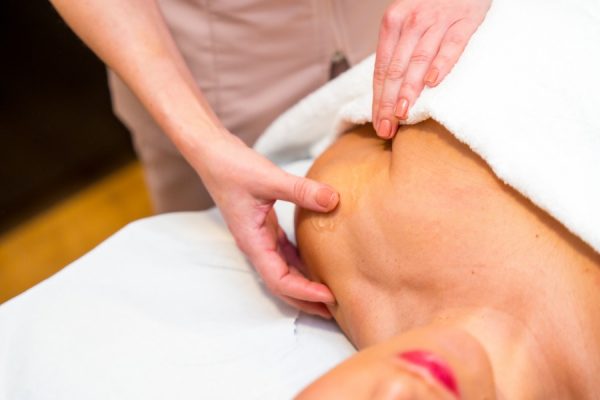Today, so much of our daily routine involves being centered around a screen. Whether it’s smartphones, tablets, laptops, or desktops, we rely on devices for everything from work and entertainment to shopping and communicating with others.
But as efficient and addictive as these devices can be, prolonged usage does come with inevitable challenges. In fact, there’s even a modern health term that’s used to describe one of the most common problems associated with too much screen use – “tech neck.”
This postural ailment is more than just a passing discomfort; it’s a growing concern that affects people of all ages. Fortunately, massage therapy offers powerful solutions that can alleviate the symptoms of tech neck and support long-term posture correction.
What is Tech Neck?
Tech neck is a term that’s used to describe the neck pain and stiffness caused by looking down at electronic devices for extended periods. For instance, did you know that when you tilt your head forward by just 15 degrees, it adds about 27 pounds of stress to your neck muscles? This means that tilting it 60 degrees can cause pressure that can exceed 60 pounds. Over time, this unnatural alignment leads to a variety of posture and pain-inducing problems, including muscle fatigue, joint strain, reduced flexibility, and even permanent changes to your spine’s natural curvature.
Some of the most common physical symptoms of tech neck include:
- Chronic neck and shoulder pain
- Headaches originating at the base of the skull
- Tingling or numbness in the arms and hands
- Reduced range of motion
- Tightness in the upper back and shoulders
Because most people believe that these symptoms are just a result of using tech devices, they rarely consider how their long-term health might be impacted by them. The reality is, if tech neck is left unaddressed, its symptoms can progress into far more serious musculoskeletal issues, including herniated discs and nerve compression.
How Massage Therapy Helps Relieve Tech Neck Symptoms
Massage therapy is one of the most effective non-invasive ways to treat tech neck. It works because it targets the muscles and soft tissues that are being affected by poor posture. When applied by a professional, massage provides both immediate relief and long-term benefits. Here are five reasons why massage therapy is the best way to manage tech neck symptoms.

- Massage Relieves Muscle Tension and Spasms
One of the primary benefits of massage is its ability to reduce muscle tension. Therapists can use deep tissue or trigger point massage to release knots and adhesions in the trapezius, levator scapulae, and suboccipital muscles — the areas most commonly strained by forward head posture. Releasing this tension automatically helps reduce pain and improve mobility.
- Massage Improves Circulation
Tight muscles restrict blood flow, and this leads to inflammation and slower recovery. Massage promotes healthy circulation, delivering oxygen and nutrients to the affected tissues while also removing waste products. Better circulation supports healing and reduces inflammation associated with repetitive stress.
- Massage Enhances Postural Awareness
Massage therapy not only treats the physical symptoms of tech neck but it also increases body awareness. Therapists often help clients recognize their postural habits and imbalances during sessions. By learning where your body holds tension, you can begin correcting your posture outside of the treatment room.
- Massage Restores Range of Motion
As tech neck develops, the neck and upper back gradually loses flexibility. Regular massage sessions help lengthen and loosen tight muscles, restoring a fuller range of motion in the neck and shoulders. This makes it easier to maintain a healthy, upright posture during daily tasks.
- Massage Helps Reduce Headaches
Tension-type headaches are common among those with tech neck because the trigger points in the neck and shoulder muscles are usually affected. A skilled massage therapist can locate and release these trigger points, providing relief from chronic headaches and reducing their frequency.
What are the Best Massage Techniques for Tech Neck?
There are several massage modalities that can effectively treat tech neck. Here are a few of the most recommended:
- Deep Tissue Massage: Focuses on the deeper layers of muscle and fascia. This type of massage is ideal for breaking down chronic tension and scar tissue.
- Trigger Point Therapy: Targets specific tight areas in muscle tissue that cause referred pain elsewhere in the body.
- Myofascial Release: Involves gentle sustained pressure on the connective tissue to release restrictions and improve mobility.
- Swedish Massage: Uses long, gliding strokes and gentle pressure, perfect for stress relief and circulation enhancement.
- Neck and Shoulder Focus Sessions: Customized sessions that hone in on the upper back, shoulders, and neck — the core areas impacted by tech neck.

Incorporating Massage into a Posture Wellness Plan
Massage is an easy solution that can benefit anyone suffering from tech neck, but it is most effective when it is paired with other healthy lifestyle choices. If you are serious about putting an end to your tech neck symptoms, then following a more comprehensive posture wellness plan is recommended. Along with regular massage session, here are a few additional ways to enhance your results:
- Stretching and Strengthening Exercises: Gentle stretches and posture-strengthening routines (such as chin tucks and scapular squeezes) can help support muscle balance.
- Ergonomic Adjustments: If you work at a computer all day, then arrange your workstation so your screen is at eye level. Use standing desks if or when possible.
- Take Regular Breaks: Follow the 20-20-20 rule: every 20 minutes, look at something 20 feet away for at least 20 seconds. Stand, stretch, and move frequently to help prevent your muscles from freezing up.
- Hydrate and Sleep Well: Proper hydration and quality sleep are vital for muscle recovery and getting enough of both can greatly help reduce the overall tension in your body.

When to See a Professional Massage Therapist for Tech Neck
If you’ve been experiencing persistent neck pain, tension headaches, or numbness in your upper limbs, then it’s time to seek professional help. A licensed massage therapist can assess your posture and tailor sessions to address your specific symptoms. If you have a severe case of tech neck, then you may even be referred to a physical therapist or chiropractor for additional support.
Protect Your Neck! Schedule a Consultation with a Skilled Massage Therapist Today
Living with tech neck can truly be a pain in the neck, but it doesn’t have to become a permanent part of your life. By addressing the root causes of poor posture through massage therapy, you can find relief from the pain, improve your flexibility, and develop healthier habits that can help you live a more balanced, pain-free future.
Since we live in a digital age, there’s not much we can do to stop our dependence on small screen devices. That’s why taking time for therapeutic massage is such a smart investment. Massage therapy will benefit your physical well-being.
If you’re interested in finding out how massage can effectively address your tech neck pain, or want to learn more about it, just give Birmingham Massage Couple a call today at 205-529-1516 or 205-381-1645. Or, you can click here to schedule your evaluation online.






